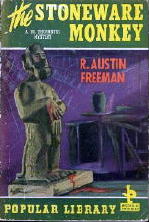Wed 21 Oct 2009
A Review by David L. Vineyard: MARK GATISS – The Vesuvius Club.
Posted by Steve under Bibliographies, Lists & Checklists , Characters , ReviewsNo Comments
MARK GATISS – The Vesuvius Club: A Bit of Fluff. Simon & Schuster, UK, hardcover, November 2004; Scribner’s; US, trade pb, October 2005.

So speaks Lucifer Box (“I have a horror of artichokes.”), Edwardian portraitist, and His Majesty’s most daring — and decadent — secret agent, spy, and when the need arises, assassin, the hero of Mark Gatiss’s novel of mystery, conspiracy, dirty doings, and — of course a threat to the future of the Western world and particularly the waning sun of the British Empire post Victoria.
Box, who lives at Number 9 Downing Street (because somebody has to), has been assigned to find the missing agent Jocelyn Utterson Poop aided by his hench-woman and nude model Delilah, who has just helped him dispose of his late luncheon guest Everard Supple, a treasonous diplomat:

The decidedly bi-sexual Box is dispatched by his chief (Joshua Reynolds, a dwarf who gives out his assignments from a bathroom, “Three foot something in his stocking feet and ever so jolly.”) to a case involving the beautiful Miss Bella Pok, his boy assistant handsome Charlie Jackson, and the grizzled vulcanologist Emmanuel Quibble, as well as poisoned centipedes, foggy London chases, kidnapped scientists, and a plot to set off Mount Vesuvius by a Neapolitan secret criminal society.
It’s a wild chase, equal parts Oscar Wilde, Fu Manchu, H.P. Lovecraft,. Monty Python, The Avengers, James Bond, and Austin Powers. The tale is spun by Gatiss, an award winning star and co-creator of the British comedy, The League of Gentlemen and sometime writer for Doctor Who, in a perfectly toned voice that sparkles with witty epigrams and playful adventure.

Of course you may find Lucifer Box a bit of a scoundrel, but his raffish adventures among the seedier side of the Edwardian demimonde are outlandishly entertaining and addictive.
There is even a twist in the tale of near poetic justice for our hero. Which of course he escapes — you can’t very well succumb in the first book in a series. Simply bad taste, that.
And you’ll be smiling too, though perhaps not as dashed devilishly. A tasty and charming bit of fluff, exactly the thing for a cold winter’s night.
The Lucifer Box series —
1. The Vesuvius Club (2004)
2. The Devil in Amber (2006)
3. Black Butterfly (2008)





















